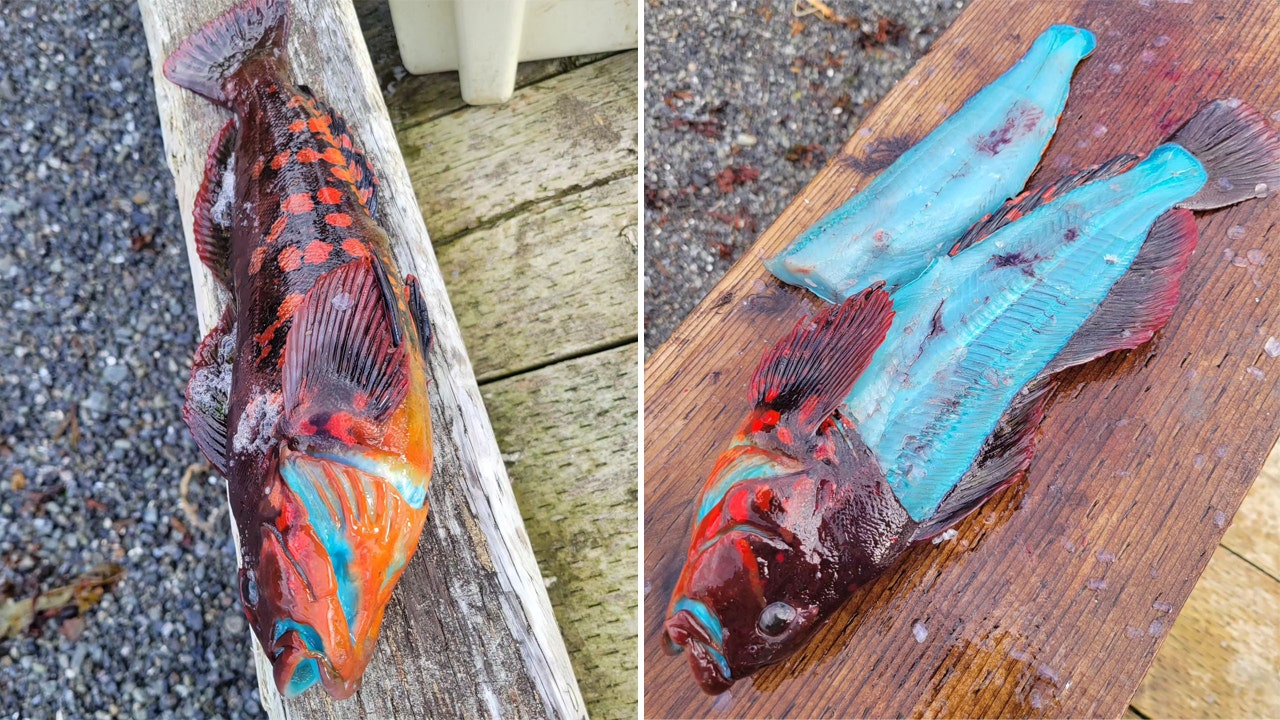Alaska
Fisherman in Alaska reels in catch that’s bright blue on the inside: ‘Pretty crazy’

An Alaskan fisherman documented a vibrant, orange-speckled catch that has natural blue flesh, and he shared what the fish looks like when cooked.
Joe Chmeleck, owner of The Lodge at Otter Cove, in Homer, Alaska, reeled in a rock greenling late last month, according to posts he shared on Facebook and Instagram.
“Went out fishing today and caught a rock greenling,” Chmeleck wrote on Aug. 28. “The flesh is blue. It turns white when you cook it. Mother nature is incredible.”
VIRGINIA FISHERMAN CATCHES ‘EXTREMELY RARE’ BLUE-MOUTH FISH: ‘WILD GENETIC PIGMENT MUTATION’
In a follow-up video that Chmeleck posted to Facebook, he showed the fully-skinned blue fish fillets changed color when pan-fried in oil.
Many commenters under his social media posts wrote that they didn’t know a fish species like this existed.
Joe Chmeleck, a fisherman from Homer, Alaska, caught a rock greenling in late August. The fish has natural blue flesh. (Lodgeottercove.com via Storyful)
“What a incredible beautiful looking fish,” one Facebook user wrote.
“That’s pretty crazy. I’ve never seen anything like that,” an Instagram user wrote.
“That’s amazing!! Had no idea such a fish existed,” another Facebook user wrote.
‘RARE’ FISH ENDANGERED IN TWO US STATES HAS RESEARCHERS WORKING TO SAVE SPECIES FROM EXTINCTION
In a statement, Chmeleck said the rock greenling he caught tasted similar to trout.
The Alaska Department of Fish and Game has been unable to offer consumption advice on rock greenlings because the agency hasn’t been successful in gathering a sufficient sample size to determine mercury levels for the species.

Joe Chmeleck sliced the rock greenling he caught in half to show the difference between the fish’s blue flesh and orange-speckled scales. (Lodgeottercove.com via Storyful)
Rock greenlings, also known as Hexagrammos lagocephalus, are a ray-finned marine fish that are typically found along the northern Pacific Coast, from the Point Conception State Marine Reserve in California to the Bering Sea in Alaska, according to various government wildlife records.
The Oregon Department of Fish & Wildlife and the Washington Department of Fish & Wildlife both state rock greenlings possess dark scales that have a “mottled” pattern, which can range from brown, red, orange and green, so the fish species can blend in with rocky environments.
RECORD-BREAKING FISH: HUGE CATCHES THAT MADE HEADLINES IN 2022
While the fish seems to have evolved for camouflaging, rock greenlings have blue or blue-green mouths and flesh, according to both wildlife agencies.
Scientists aren’t certain why rock greenlings have blue-green pigments in their tissue, but they know the coloring happens because the fish biologically produce biliverdin, a green bile, according to the Oregon Sea Grant, a marine research foundation.
Rock greenlings feed on sea worms, crustaceans, and small fishes, according to the California Department of Fish & Wildlife.

Joe Chmeleck’s rock greenling had a bright blue mouth that contrasted with its deep orange skin. (Lodgeottercove.com via Storyful)
Typically, the fish species can grow up to 24 inches in length and weigh up to 1.83 pounds, according to the Washington Department of Fish & Wildlife.
CLICK HERE TO SIGN UP FOR OUR LIFESTYLE NEWSLETTER
Chmeleck’s posts about the fish have generated over 1,000 reactions, 600 comments and 3,700 shares on Facebook and Instagram combined.
For more Lifestyle articles, visit www.foxnews/lifestyle

Alaska
Sky Watch Alaska: planets align plus the aurora forecast

ANCHORAGE, Alaska (KTUU) – This is a great time of year to do some star gazing. If you have clear skies in your part of Alaska, take the time to check out the night — and morning — sky.
After sunset, look toward the southwest. Saturn and Venus are snuggled up together (of course, they are more than 800 million miles apart) in the evening sky. They set at about 9:40 p.m. in Southcentral.
Before 9:40 p.m., you can see four planets with the naked eye — Saturn, Venus, Jupiter and Mars. Jupiter and Mars stick around through the morning. Mars is very close to the moon right now.
The Aurora forecast is fairly weak for the next few weeks. That’s not to say there won’t be the occasional burst but overall, solar activity is expected to be fairly low until the beginning of February.
If you get great pictures of the planets, the sky, or the aurora, don’t forget to send them to Alaska’s News Source.
See a spelling or grammar error? Report it to web@ktuu.com
Copyright 2025 KTUU. All rights reserved.
Alaska
Short-lived cold snap, with another warming trend this weekend

ANCHORAGE, Alaska (KTUU) – Temperatures across the state are cooling off, as our strong low from the weekend moves into the Chukchi Sea. This will set up for colder air to spread across the state this week, as another short-lived cold snap is expected. While some light snow is possible for the Interior, areas of the Slope and Western Alaska, Southcentral will stay on the drier side until the night. Meanwhile, Southeast will continue to hold onto moderate rain with gusty conditions.
SOUTHCENTRAL:
Temperatures this morning are 10 to 20 degrees colder than yesterday, as colder air has settled back into Southcentral. Clear skies and calm winds are evident this morning for parts of the region, with light snow falling through the Copper River Basin. We’ll see fairly quiet conditions today, outside of Kodiak which will see increasing snow and rain into the afternoon and evening hours. This comes as our next area of low pressure moves up the Alaska Peninsula.
We’ll see light snow spreading north across the Kenai overnight into Wednesday, with light snow expected through Prince William Sound. Several inches are likely through the Kenai and Chugach Mountains, with the pass expected to see a couple of inches of accumulation. Western parts of the Kenai will see the potential for a few inches, while inland areas of Southcentral largely stay dry. If Anchorage and surrounding locations see any accumulation, it’ll amount to less than half an inch.
As snow tapers off Wednesday, we’ll see the return to colder and drier conditions into Thursday. Thursday may be the coldest day this week across the region, before another warming trend carries us into next week. Right now holding with snow through early next week, but areas of wintry mix are possible as highs warm above freezing.
SOUTHEAST:
The winter storm warning for Skagway and higher elevations expired at 6am this morning. While some light snow showers are still possible, little accumulation will occur the rest of the day. Scattered to periodic showers are occurring elsewhere across Southeast today, with less than half an inch of rainfall through the day. Any moisture available into the evening will see a transition to some wintry mix or snow into Wednesday morning. However, the better chance will come from another low lifting north into the panhandle. Any snow and wintry mix we see for Wednesday will primarily stay confined to the central and southern panhandle. We’ll see much cooler weather taking hold this week for Southeast.
INTERIOR:
Some areas of light snow are possible this morning, with less than half an inch to be expected. While temperatures are still warm for much of the Interior, highs will steadily fall throughout the day. Many areas will see lows bottom out near or below zero by tomorrow morning. We’ll see high pressure keep things dry and sunny through the next couple of days, with the coldest stretch of weather from Wednesday morning into Thursday morning. Much like the rest of the state will experience, a warming trend arrives this weekend. We’ll see the return to highs in the 20s, with some snow in the forecast. Be prepared for some gusty conditions through the Alaska Range by the close of this week.
SLOPE/WESTERN ALASKA:
Areas of light snow and blowing winds will continue to impact the Slope, with a winter weather advisory remaining in place for the Central Brooks Range and the Beaufort Sea Coast. Both locations will see up to 1 inch of snow and gusty winds up to 35 mph. While the winter weather advisory will expire for the Central Brooks Range this afternoon, the Beaufort Sea Coast will see the alert continue into Tuesday evening. Snow and blowing snow will be the primary impact today, with a return to colder weather through the rest of this week, this comes as high pressure settles into the area.
The storm responsible for the damaging winds for Southcentral over the weekend, has pushed north into the Chukchi Sea. We’ll still see some light snow accumulations for Western Alaska, with 1 to 3 inches expected. Some fo the heaviest snow will fall across the Seward Peninsula and the Western Brooks Range.
An area of low pressure in the Bering Sea will keep gusty winds and snow in the forecast for Gambell/St. Lawrence. Be prepared for heavy snow at times and areas of reduced visibility. Overall, colder weather will settle into Western Alaska, with the possibility of morning fog in the valleys over the next few mornings.
ALEUTIANS:
Some light areas of snow will occur for the Pribilof Islands and into parts of the Alaska Peninsula today, as a weak low moves up the Peninsula. This will be the main focus for snow into Wednesday for Southcentral. This low will bring heavy precipitation and gusty winds for the Eastern Aleutians and the Alaska Peninsula. Looking ahead through the rest of the week, we can expect to see more a ridge beginning to build into the region. This ridge will slowly shift east, keeping several upper level disturbances traversing the Aleutians. Temperatures will remain fairly warm in the 30s and 40s.
OUTLOOK AHEAD:
Model consensus continues to agree on another warming trend heading our way into next week. This stretch of warmth will likely lead to many spots cementing themselves within the top warmest January’s on record. While we’ll spend the rest of this week on the colder side, highs steadily climb this weekend into next week. We’ll see highs in Southcentral climbing back above freezing, with areas of the Interior climbing back into the 20s.
Have a safe and wonderful Tuesday!
See a spelling or grammar error? Report it to web@ktuu.com
Copyright 2025 KTUU. All rights reserved.
Alaska
Anchorage, Alaska hit by hurricane-force winds, structures damaged across city

Associated Press
Hurricane-force winds cause widespread damage in Alaska’s largest city
Thousands of residents across Alaska’s largest city were still without power Monday, a day after a powerful storm brought hurricane-force winds that downed power lines, damaged trees, forced more than a dozen planes to divert, and caused a pedestrian bridge over a highway to partially collapse. A 132-mph (212-kph) wind gust was recorded at a mountain weather station south of Anchorage. A large low-pressure system in the Bering Sea brought the high winds, moisture and warmer than average temperatures — in the low 40s Fahrenheit (slightly over 4.4 degrees Celsius) — to Anchorage on Sunday, said National Weather Service meteorologist Tracen Knopp.
-

 Health1 week ago
Health1 week agoOzempic ‘microdosing’ is the new weight-loss trend: Should you try it?
-
/cdn.vox-cdn.com/uploads/chorus_asset/file/25822586/STK169_ZUCKERBERG_MAGA_STKS491_CVIRGINIA_A.jpg)
/cdn.vox-cdn.com/uploads/chorus_asset/file/25822586/STK169_ZUCKERBERG_MAGA_STKS491_CVIRGINIA_A.jpg) Technology6 days ago
Technology6 days agoMeta is highlighting a splintering global approach to online speech
-

 Science4 days ago
Science4 days agoMetro will offer free rides in L.A. through Sunday due to fires
-
/cdn.vox-cdn.com/uploads/chorus_asset/file/25821992/videoframe_720397.png)
/cdn.vox-cdn.com/uploads/chorus_asset/file/25821992/videoframe_720397.png) Technology1 week ago
Technology1 week agoLas Vegas police release ChatGPT logs from the suspect in the Cybertruck explosion
-

 Movie Reviews1 week ago
Movie Reviews1 week ago‘How to Make Millions Before Grandma Dies’ Review: Thai Oscar Entry Is a Disarmingly Sentimental Tear-Jerker
-

 Health1 week ago
Health1 week agoMichael J. Fox honored with Presidential Medal of Freedom for Parkinson’s research efforts
-

 Movie Reviews1 week ago
Movie Reviews1 week agoMovie Review: Millennials try to buy-in or opt-out of the “American Meltdown”
-

 News1 week ago
News1 week agoPhotos: Pacific Palisades Wildfire Engulfs Homes in an L.A. Neighborhood















